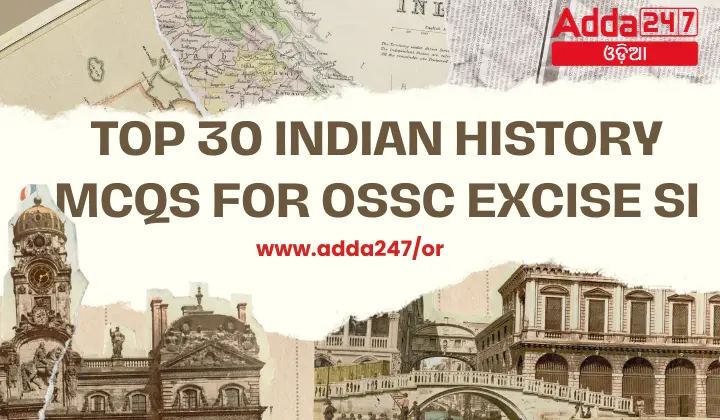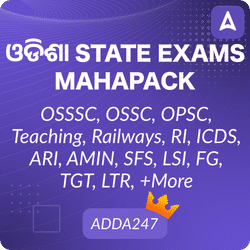Mastering Indian History is essential for excelling in competitive exams like the OSSC (Odisha Staff Selection Commission) Excise SI (Sub-Inspector) exam. Indian history is a vast subject, spanning thousands of years and encompassing various dynasties, rulers, events, and cultural developments. To assist aspirants in their preparation, we have compiled a list of the top 30 multiple-choice questions (MCQs) covering significant periods and themes in Indian history.
Top 30 Indian History MCQs For OSSC Excise SI
- During which historical period did the people of Harappa and Mohenjo-Daro culture belong?
A. New Stone Age
B. Copper Age
C. Iron Age
D. Chalcolithic Age
Ans: D. Chalcolithic Age - In which caves is the Kailasha temple located?
A. Ajanta
B. Ellora
C. Elephanta
D. Karle
Ans: B. Ellora - Match the following dynasties with their respective capitals:
List-I List-II
A. Satavahana 1. Magadha
B. Cheta 2. Peshawar
C. Kushan 3. Kalinga
D. Koshala 4. Bagat
Codes:
A B C D
(a) 2 1 3 4
(b) 3 4 2 1
(c) 2 4 3 1
(d) 3 1 2 4
Ans: (b) 3 4 2 1 - The words “Satyameva Jayate” in the State Emblem adopted by the Government of India have been taken from which Upanishad?
A. Aitareya Upanishad
B. Mundaka Upanishad
C. Adhyatma Upanishad
D. Prasna Upanishad
Ans: B. Mundaka Upanishad - Who among the following rulers was the first to embrace Buddhism?
(a) Ashoka
(b) Ajatasatru
(c) Bindusara
(d) Bimbisara
Ans: (a) Ashoka - Which Gupta ruler faced invasion by the Hunas?
A. Budhagupta
B. Kumaragupta-I
C. Kumaragupta-II
D. Skandagupta
Ans: A. Budhagupta - How did the Maurya Empire finally end?
A. The last Mauryan ruler was killed by his General.
B. The Kanvas of Central India deposed the last Mauryan ruler.
C. The last Mauryan ruler was killed in a battle with the foreign invader from the northwest.
D. The last Mauryan ruler had no heir, and the throne was claimed by one of his powerful ministers.
Ans: A. The last Mauryan ruler was killed by his General. - Under which Rashtrakuta king was the famous Kailasa temple at Ellora constructed?
A. Amoghavarsha-I
B. Govinda-III
C. Indra-III
D. Krishna-I
Ans: D. Krishna-I - The Rathas of Mahabalipuram, showcasing rock-cut architecture, were built by a king of which dynasty?
A. Chola
B. Hoysala
C. Pallava
D. Rashtrakuta
Ans: C. Pallava - Match the following dynasties with their respective capitals:
List-I List-II
A. Cholas 1. Dwarasamudra
B. Hoysalas 2. Madurai
C. Pandyas 3. Malkhed
D. Rashtrakutas 4. Tanjavur
Codes:
A B C D
(a) 4 1 2 3
(b) 3 2 1 4
(c) 4 2 1 3
(d) 3 1 2 4
Ans: (a) 4 1 2 3 - Which of the following rulers was a contemporary of the famous Buddhist scholar Ashvaghosha?
A. Ashoka
B. Bindusara
C. Harsha
D. Kanishka
Ans: D. Kanishka - Gupta period is often termed the ‘Golden Age’ of ancient India because:
A. The Gupta rulers issued gold coins.
R. The Gupta period is often called the ‘Golden Age’ of ancient India.Codes:
A. Both A and R is true and R is the correct explanation of A
B. Both A and R is true but R is not a correct explanation of A
C. A is true but R is false
D. A is false but R is true
Ans: B. Both A and R are true but R is not a correct explanation of A - Nalanda was the centre of Buddhist learning in the post-Gupta period, and it was patronized by the Pal a rulers.
A. Nalanda was the centre of Buddhist learning in the post-Gupta period.
R. It was patronized by the Pal a rulers.Codes:
A. Both A and R is true and R is the correct explanation of A
B. Both A and R is true but R is not a correct explanation of A
C. A is true but R is false
D. A is false but R is true
Ans: B. Both A and R are true but R is not a correct explanation of A - Initially, only high caste Kshatriya communities adopted Jainism, although Vardhaman Mahavira belonged to a well-known Kshatriya community.
A. In the beginning, only high caste Kshatriya communities adopted Jainism.
R. Vardhaman Mahavira belonged to a well-known Kshatriya community.Codes:
A. Both A and R is true and R is the correct explanation of A
B. Both A and R is true but R is not a correct explanation of A
C. A is true but R is false
D. A is false but R is true
Ans: B. Both A and R are true but R is not a correct explanation of A - Chandragupta Maurya failed in his first campaign against Magadha because he did not begin with the frontiers, but invaded the heart of Magadha.
A. Chandragupta Maurya failed in his first campaign against Magadha.
R. He did not begin with the frontiers, but invaded the heart of Magadha.Codes:
A. Both A and R is true and R is the correct explanation of A
B. Both A and R is true but R is not a correct explanation of A
C. A is true but R is false
D. A is false but R is true
Ans: A. Both A and R are true and R is the correct explanation of A - The Jainas follow the practice of worshipping images of tirthankaras, although they denied the existence of a Supreme Being.
A. The Jainas follow the practice of worshipping images of tirthankaras.
R. They denied the existence of a Supreme Being.Codes:
A. Both A and R is true and R is the correct explanation of A
B. Both A and R is true but R is not a correct explanation of A
C. A is true but R is false
D. A is false but R is true
Ans: B. Both A and R are true but R is not a correct explanation of A - The Kushanas issued a large number of gold coins because the period was marked by flourishing trade.
A. The Kushanas issued a large number of gold coins.
R. The period was marked by flourishing trade.Codes:
A. Both A and R is true and R is the correct explanation of A
B. Both A and R is true but R is not a correct explanation of A
C. A is true but R is false
D. A is false but R is true
Ans: A. Both A and R are true and R is the correct explanation of A - There is no conclusive proof of the presence of temples or public places of worship in the Indus civilization, indicating that religion was perhaps more a personal and a private matter than a public affair to the Harappans.
A. There is no conclusive proof of the presence of temples or public places of worship in the Indus civilization.
R. To the Harappans, religion was perhaps more a personal and a private matter than a public affair.Codes:
A. Both A and R are true and R is the correct explanation of A
B. Both A and R are true but R is not a correct explanation of A
C. A is true but R is false
D. A is false but R is true
Ans: C. A is true but R is false - The Harappan civilizations lack homogeneity or uniformity in burial practices.
A. The Harappan civilizations do not have homogeneity or uniformity in weights and measures.
B. The Harappan civilizations do not have homogeneity or uniformity in cereal crops.
C. The Harappan civilizations do not have homogeneity or uniformity in burial practices.
D. both (B) and (C)
Ans: C. burial practices - The prominent Harappan site surrounded by flood barriers to protect it with the aid of UNESCO funds is Mohenjodaro.
A. Mohenjodaro
B. Dholavira
C. Lothal
D. Rakhigarhi
Ans: A. Mohenjodaro - Which of the following pairs is incorrectly matched?
A. Askini – Chenab
B. Sutudri – Sutlej
C. Vipas – Jhelum
D. Parushni – Ravi
Ans: C. Vipas – Jhelum - The origin of Indian music can be traced to which of the following Vedic Samhitas?
A. Rigveda
B. Samaveda
C. Yajurveda
D. Atharvaveda
Ans: B. Samaveda - The first elaborate description of Upanayana Sanskar is found in the
A. Aitareya Brahmana
B. Taittiriya Brahmana
C. Tandyamaha Brahmana
D. Shatapatha Brahmana
Ans: C. Tandyamaha Brahmana - Which of the following pairs is correctly matched?
A. Buddhist monastery
B. Buddhist order or organisation
C. A kind of tomb where the relics of Buddha and other Buddhist monks are kept
D. A Buddhist assembly hall or temple
Ans: C. A kind of tomb where the relics of Buddha and other Buddhist monks are kept - Which one of the following sources states that Srinagar was built by Ashoka?
A. Kalhana’s Rajatarangini
B. Divyavadana
C. Tarantha’s History of Tibet
D. Mahavamsa
Ans: A. Kalhana’s Rajatarangini - Which one of the following pairs does not belong to the same category?
A. Mauryas – Brihadratha
B. Satavahanas – Simuka
C. Sungas – Devabhuti
D. Kanvas – Susaraman
Ans: B. Satavahanas – Simuka - Patanjali, the second great grammarian of Ancient India, was a contemporary of
A. Kanishka
B. Chandragupta-II
C. Gautamiputra Satakarni
D. Pushyamitra Sunga
Ans: D. Pushyamitra Sunga - Who was the founder of the Satavahana dynasty?
A. Sri Satakarni
B. Simuka
C. Pulumayi-I
D. Yajnasri Satakarni
Ans: B. Simuka - Who was the founder of the Kanva dynasty?
A. Suserman
B. Vishnusarma
C. Vassudeva
D. Vasumitra
Ans: C. Vassudeva - Who started the Saka Era and when?
A. Kadphises in 58 BC
B. Rudradaman-I in 78 AD
C. Vikramaditya in 58 BC
D. Kanishka in 78 AD
Ans: B. Rudradaman-I in 78 AD










